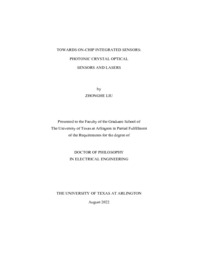| dc.description.abstract | Supervising Professor: Weidong Zhou
The field of compact integrated optical platform has developed into a new era in the past two decades. On one hand, the semiconductor optoelectronic devices are becoming smaller and cheaper thanks to the development of complementary metal-oxide semiconductor (CMOS) fabrication technologies; on the other hand, the applications of optoelectronics have been deeply coupled to other fields to realize more complicated implementations. Photonic crystal slab (PCS) structure has been playing an increasingly important role in these optical devices, active or passive, by enabling a variety of light-matter interaction mechanisms. The objective of this dissertation is to investigate photonic crystal devices towards on-chip integration of optical sensing system. In addition to PCS optical sensing structures, compact photonic crystal lasers and laser cavities are also being investigated. The phase tuning capabilities in PCSs have also been investigated theoretically, for applications in high sensitivity sensing, and in phase front engineering for flat optic metalens. The background and motivations of this dissertation will be discussed in more details in Chapter 1.
Bioresorbable implantable optical sensors are an emerging optical sensor which dissolves in the body after pre-defined performance period. As described in Chapter 2, we first investigated the design and fabrication of optical pressure and temperature sensors with standard CMOS process from bioresorbable materials. Millimeter-scale Fabry-Perot cavities and two-dimensional photonic crystal structures are designed and fabricated entirely with bioresorbable materials to enable precise, continuous measurements of pressure and temperature across physiologically relevant ranges, for clinically relevant timescales before naturally resorbing into the body. Combined mechanical and optical simulations reveal the fundamental sensing mechanisms in both cases. In vitro studies and histopathological evaluations quantify the measurement accuracies, the operational lifetimes, and the biocompatibility of these systems. Demonstrations in intracranial pressure and temperature monitoring in live animal models establish clinically relevant performance attributes.
Large area monolayer 2D material integrated PC laser has also been investigated, as shown in Chapter 3. The viscoelastic stamp transfer technique was developed for large area (over 100 mm sized) monolayer 2D WS2 material preparation and integration processes. Wafer scale monolayer 2D materials were also used in the project for the demonstration of large array size lasers based on WS2 material. 2D material transfer-printing process on an automatic assembly platform was also developed for high quality 2D material transfer printing and stacking.
Additionally, photonics crystal nanobeam (PCNB) cavity is an ideal candidate for high performance, low energy consumption and high-speed semiconductor lasers for its superior characteristics of ultra-compact size, extreme low mode volume (V), and high quality (Q) factor. We investigate the design, fabrication, and characterization of suspended arrays of small volume, high quality factor (Q) silicon nitride photonic crystal nanobeam (PCNB) cavities with lateral nanorod fin structures. The work is presented in Chapter 4. By controlling the alignment position of the fins with respect to the air holes, the resonance wavelength and Q-factor of the PCNB cavities can be tuned to realize the desired performance. Measured Q-factors and resonant wavelength tuning ranges of 2×104 and 10 nm are achieved respectively, with the highest Q-factor measured at 2.5×104. Incorporating such nanorod fins to the nanobeam cavity is demonstrated to provide improved mechanical support, thermal transport, and channels of lateral carrier injection for the suspended PCNB.
Finally, as shown in Chapter 5, we investigated reflective and transmissive photonic crystal optical cavities to achieve high sensitivity phase sensing with full 2p phase shift, with great potentials for high-speed phase tuning. Measurement of phase information was also demonstrated on single layer photonic crystal cavities. We also investigated an amorphous silicon photonic crystal slab (PCS) metalens structure with full 2π phase modulation, high transmission efficiency and broadband operation centered at 940 nm. The structure is an ideal candidate for large area phase manipulation with compact, reliable, and low aspect ratio patterning on a thin film. Simulation results show continuous 2π transmission phase control by tuning the air hole filling size near the degenerate band edge, and the metalens structure is achieved with efficiency above 80% and the operation wavelength over 100 nm. | |


